Cloud Computing: Advantages and Disadvantages for Business Report
VerifiedAdded on 2020/03/02
|13
|3164
|108
Report
AI Summary
This report examines the advantages and disadvantages of cloud computing for businesses. It begins with an introduction to cloud computing, defining it as a resource-sharing model that offers benefits like enhanced scalability, business continuity, collaboration efficiency, and work flexibility. The report then outlines the objectives and scope, including a review of journal articles to identify key advantages such as reduced IT costs, scalability, business continuity, collaboration efficiency, flexibility, automatic updates, portability, and manageability. It also details disadvantages such as downtime, security issues, inflexibility, customer support limitations, and limited control. The report concludes by suggesting methods for mitigating these challenges, including end-to-end encryption, regular software updates, and the utilization of single sign-on solutions to enhance security. The report underscores the significance of cloud computing in benefiting organizations by reducing costs and allowing them to focus on their core business rather than IT infrastructure.
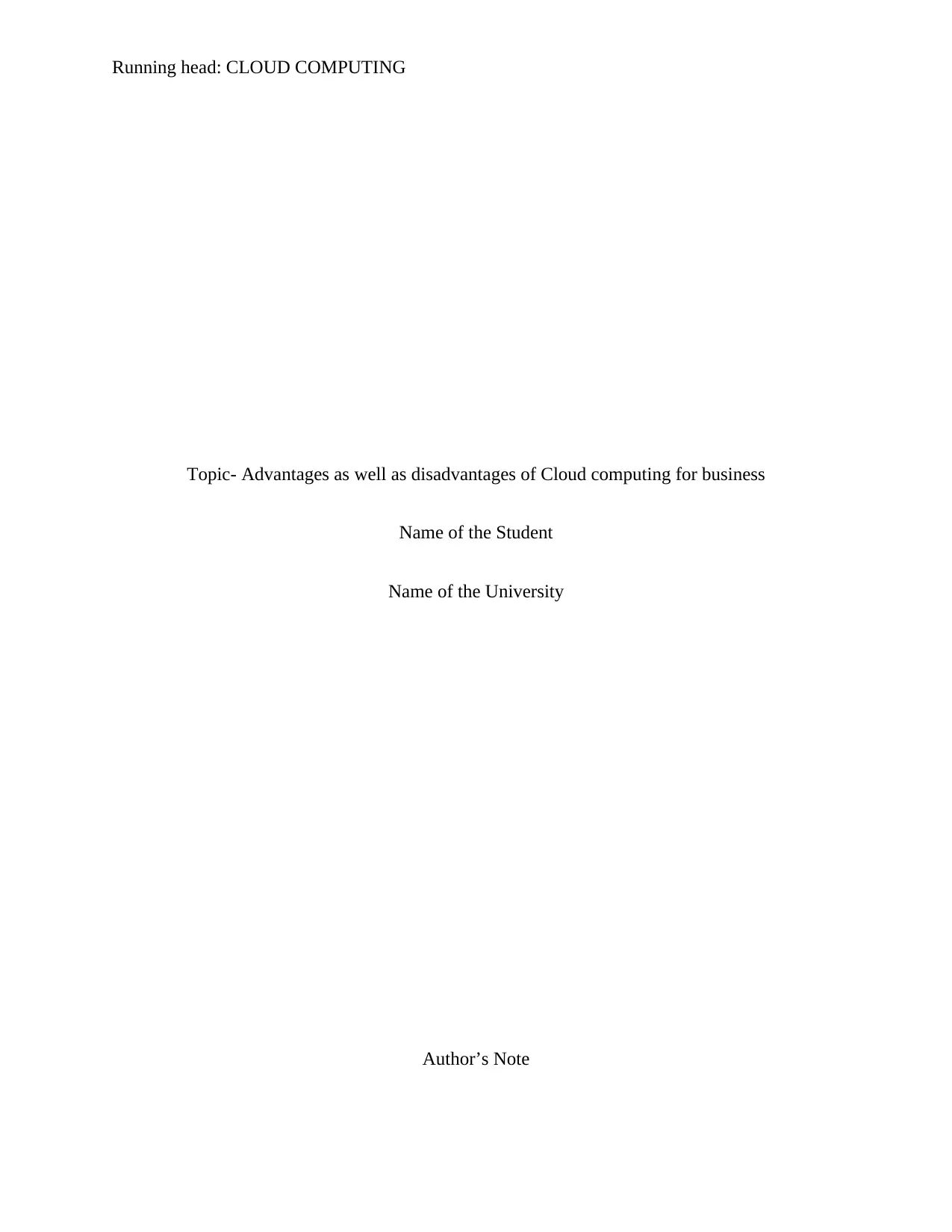
Running head: CLOUD COMPUTING
Topic- Advantages as well as disadvantages of Cloud computing for business
Name of the Student
Name of the University
Author’s Note
Topic- Advantages as well as disadvantages of Cloud computing for business
Name of the Student
Name of the University
Author’s Note
Secure Best Marks with AI Grader
Need help grading? Try our AI Grader for instant feedback on your assignments.
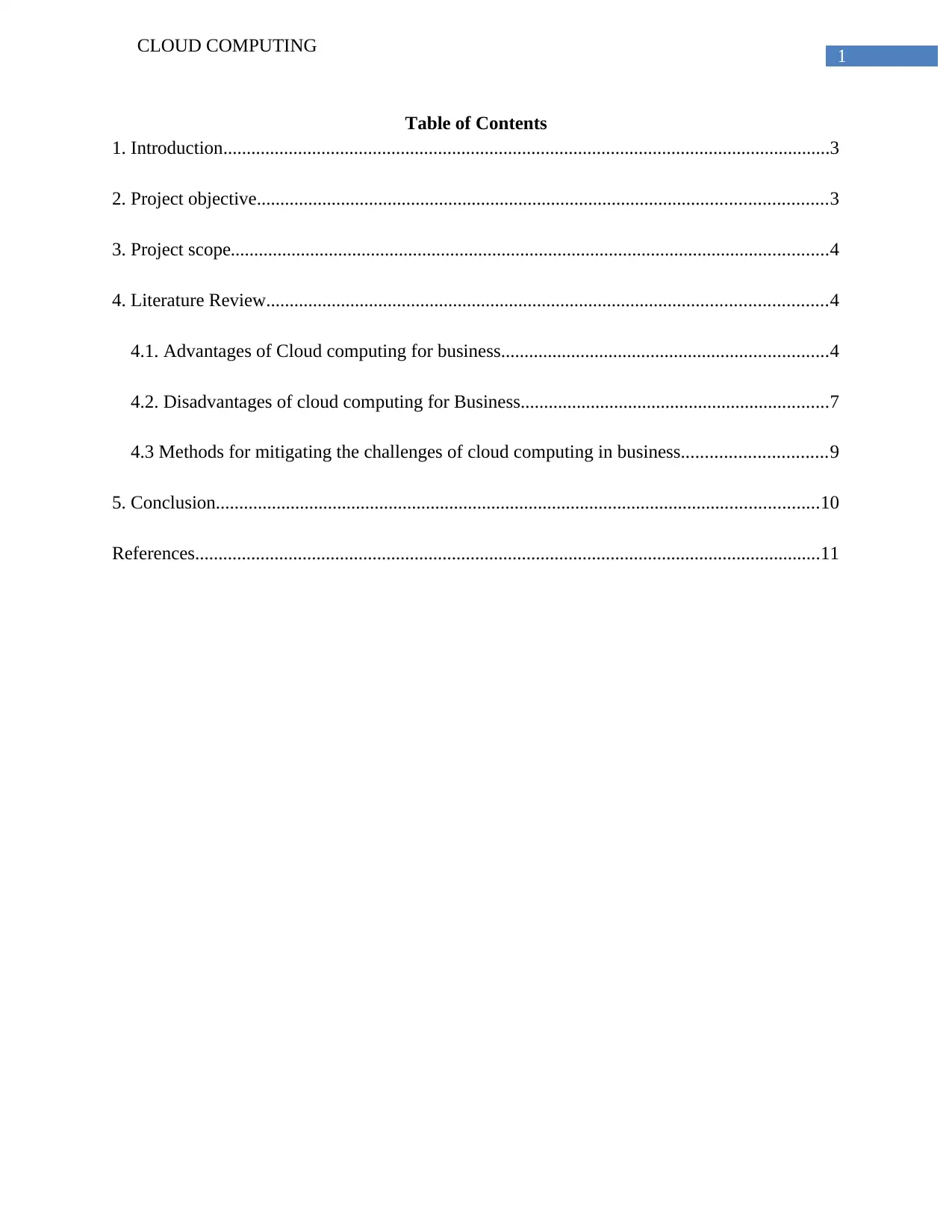
1
CLOUD COMPUTING
Table of Contents
1. Introduction..................................................................................................................................3
2. Project objective..........................................................................................................................3
3. Project scope................................................................................................................................4
4. Literature Review........................................................................................................................4
4.1. Advantages of Cloud computing for business......................................................................4
4.2. Disadvantages of cloud computing for Business..................................................................7
4.3 Methods for mitigating the challenges of cloud computing in business...............................9
5. Conclusion.................................................................................................................................10
References......................................................................................................................................11
CLOUD COMPUTING
Table of Contents
1. Introduction..................................................................................................................................3
2. Project objective..........................................................................................................................3
3. Project scope................................................................................................................................4
4. Literature Review........................................................................................................................4
4.1. Advantages of Cloud computing for business......................................................................4
4.2. Disadvantages of cloud computing for Business..................................................................7
4.3 Methods for mitigating the challenges of cloud computing in business...............................9
5. Conclusion.................................................................................................................................10
References......................................................................................................................................11
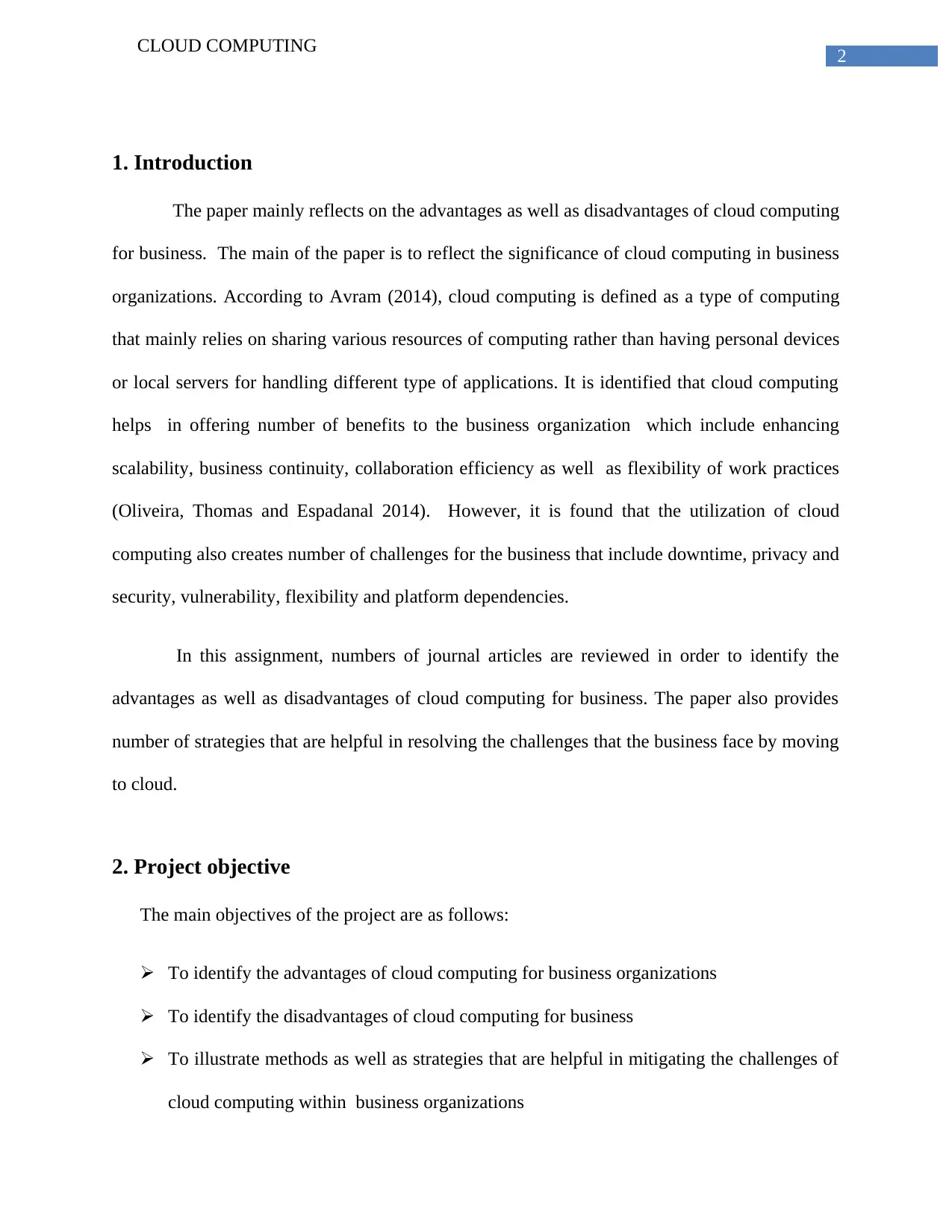
2
CLOUD COMPUTING
1. Introduction
The paper mainly reflects on the advantages as well as disadvantages of cloud computing
for business. The main of the paper is to reflect the significance of cloud computing in business
organizations. According to Avram (2014), cloud computing is defined as a type of computing
that mainly relies on sharing various resources of computing rather than having personal devices
or local servers for handling different type of applications. It is identified that cloud computing
helps in offering number of benefits to the business organization which include enhancing
scalability, business continuity, collaboration efficiency as well as flexibility of work practices
(Oliveira, Thomas and Espadanal 2014). However, it is found that the utilization of cloud
computing also creates number of challenges for the business that include downtime, privacy and
security, vulnerability, flexibility and platform dependencies.
In this assignment, numbers of journal articles are reviewed in order to identify the
advantages as well as disadvantages of cloud computing for business. The paper also provides
number of strategies that are helpful in resolving the challenges that the business face by moving
to cloud.
2. Project objective
The main objectives of the project are as follows:
To identify the advantages of cloud computing for business organizations
To identify the disadvantages of cloud computing for business
To illustrate methods as well as strategies that are helpful in mitigating the challenges of
cloud computing within business organizations
CLOUD COMPUTING
1. Introduction
The paper mainly reflects on the advantages as well as disadvantages of cloud computing
for business. The main of the paper is to reflect the significance of cloud computing in business
organizations. According to Avram (2014), cloud computing is defined as a type of computing
that mainly relies on sharing various resources of computing rather than having personal devices
or local servers for handling different type of applications. It is identified that cloud computing
helps in offering number of benefits to the business organization which include enhancing
scalability, business continuity, collaboration efficiency as well as flexibility of work practices
(Oliveira, Thomas and Espadanal 2014). However, it is found that the utilization of cloud
computing also creates number of challenges for the business that include downtime, privacy and
security, vulnerability, flexibility and platform dependencies.
In this assignment, numbers of journal articles are reviewed in order to identify the
advantages as well as disadvantages of cloud computing for business. The paper also provides
number of strategies that are helpful in resolving the challenges that the business face by moving
to cloud.
2. Project objective
The main objectives of the project are as follows:
To identify the advantages of cloud computing for business organizations
To identify the disadvantages of cloud computing for business
To illustrate methods as well as strategies that are helpful in mitigating the challenges of
cloud computing within business organizations
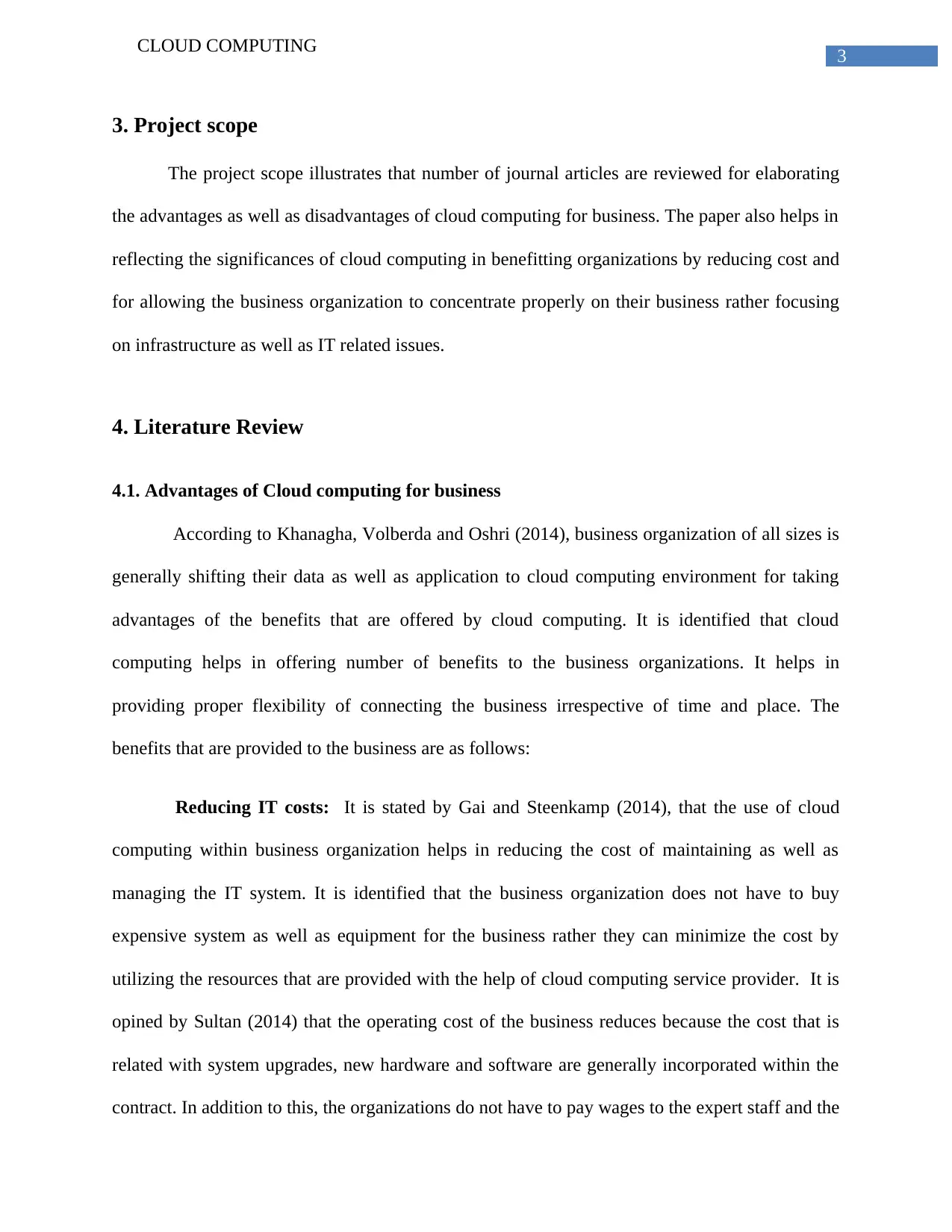
3
CLOUD COMPUTING
3. Project scope
The project scope illustrates that number of journal articles are reviewed for elaborating
the advantages as well as disadvantages of cloud computing for business. The paper also helps in
reflecting the significances of cloud computing in benefitting organizations by reducing cost and
for allowing the business organization to concentrate properly on their business rather focusing
on infrastructure as well as IT related issues.
4. Literature Review
4.1. Advantages of Cloud computing for business
According to Khanagha, Volberda and Oshri (2014), business organization of all sizes is
generally shifting their data as well as application to cloud computing environment for taking
advantages of the benefits that are offered by cloud computing. It is identified that cloud
computing helps in offering number of benefits to the business organizations. It helps in
providing proper flexibility of connecting the business irrespective of time and place. The
benefits that are provided to the business are as follows:
Reducing IT costs: It is stated by Gai and Steenkamp (2014), that the use of cloud
computing within business organization helps in reducing the cost of maintaining as well as
managing the IT system. It is identified that the business organization does not have to buy
expensive system as well as equipment for the business rather they can minimize the cost by
utilizing the resources that are provided with the help of cloud computing service provider. It is
opined by Sultan (2014) that the operating cost of the business reduces because the cost that is
related with system upgrades, new hardware and software are generally incorporated within the
contract. In addition to this, the organizations do not have to pay wages to the expert staff and the
CLOUD COMPUTING
3. Project scope
The project scope illustrates that number of journal articles are reviewed for elaborating
the advantages as well as disadvantages of cloud computing for business. The paper also helps in
reflecting the significances of cloud computing in benefitting organizations by reducing cost and
for allowing the business organization to concentrate properly on their business rather focusing
on infrastructure as well as IT related issues.
4. Literature Review
4.1. Advantages of Cloud computing for business
According to Khanagha, Volberda and Oshri (2014), business organization of all sizes is
generally shifting their data as well as application to cloud computing environment for taking
advantages of the benefits that are offered by cloud computing. It is identified that cloud
computing helps in offering number of benefits to the business organizations. It helps in
providing proper flexibility of connecting the business irrespective of time and place. The
benefits that are provided to the business are as follows:
Reducing IT costs: It is stated by Gai and Steenkamp (2014), that the use of cloud
computing within business organization helps in reducing the cost of maintaining as well as
managing the IT system. It is identified that the business organization does not have to buy
expensive system as well as equipment for the business rather they can minimize the cost by
utilizing the resources that are provided with the help of cloud computing service provider. It is
opined by Sultan (2014) that the operating cost of the business reduces because the cost that is
related with system upgrades, new hardware and software are generally incorporated within the
contract. In addition to this, the organizations do not have to pay wages to the expert staff and the
Secure Best Marks with AI Grader
Need help grading? Try our AI Grader for instant feedback on your assignments.
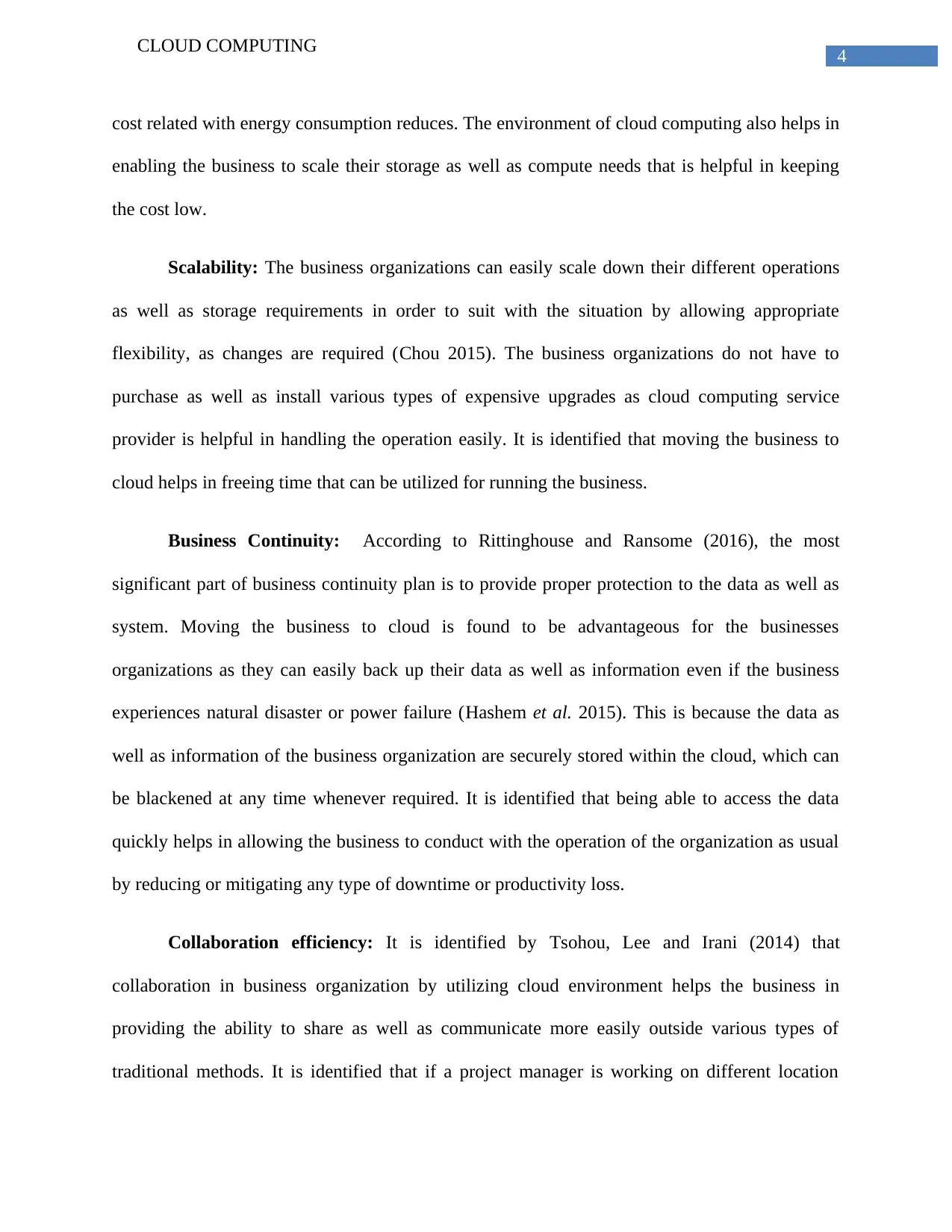
4
CLOUD COMPUTING
cost related with energy consumption reduces. The environment of cloud computing also helps in
enabling the business to scale their storage as well as compute needs that is helpful in keeping
the cost low.
Scalability: The business organizations can easily scale down their different operations
as well as storage requirements in order to suit with the situation by allowing appropriate
flexibility, as changes are required (Chou 2015). The business organizations do not have to
purchase as well as install various types of expensive upgrades as cloud computing service
provider is helpful in handling the operation easily. It is identified that moving the business to
cloud helps in freeing time that can be utilized for running the business.
Business Continuity: According to Rittinghouse and Ransome (2016), the most
significant part of business continuity plan is to provide proper protection to the data as well as
system. Moving the business to cloud is found to be advantageous for the businesses
organizations as they can easily back up their data as well as information even if the business
experiences natural disaster or power failure (Hashem et al. 2015). This is because the data as
well as information of the business organization are securely stored within the cloud, which can
be blackened at any time whenever required. It is identified that being able to access the data
quickly helps in allowing the business to conduct with the operation of the organization as usual
by reducing or mitigating any type of downtime or productivity loss.
Collaboration efficiency: It is identified by Tsohou, Lee and Irani (2014) that
collaboration in business organization by utilizing cloud environment helps the business in
providing the ability to share as well as communicate more easily outside various types of
traditional methods. It is identified that if a project manager is working on different location
CLOUD COMPUTING
cost related with energy consumption reduces. The environment of cloud computing also helps in
enabling the business to scale their storage as well as compute needs that is helpful in keeping
the cost low.
Scalability: The business organizations can easily scale down their different operations
as well as storage requirements in order to suit with the situation by allowing appropriate
flexibility, as changes are required (Chou 2015). The business organizations do not have to
purchase as well as install various types of expensive upgrades as cloud computing service
provider is helpful in handling the operation easily. It is identified that moving the business to
cloud helps in freeing time that can be utilized for running the business.
Business Continuity: According to Rittinghouse and Ransome (2016), the most
significant part of business continuity plan is to provide proper protection to the data as well as
system. Moving the business to cloud is found to be advantageous for the businesses
organizations as they can easily back up their data as well as information even if the business
experiences natural disaster or power failure (Hashem et al. 2015). This is because the data as
well as information of the business organization are securely stored within the cloud, which can
be blackened at any time whenever required. It is identified that being able to access the data
quickly helps in allowing the business to conduct with the operation of the organization as usual
by reducing or mitigating any type of downtime or productivity loss.
Collaboration efficiency: It is identified by Tsohou, Lee and Irani (2014) that
collaboration in business organization by utilizing cloud environment helps the business in
providing the ability to share as well as communicate more easily outside various types of
traditional methods. It is identified that if a project manager is working on different location
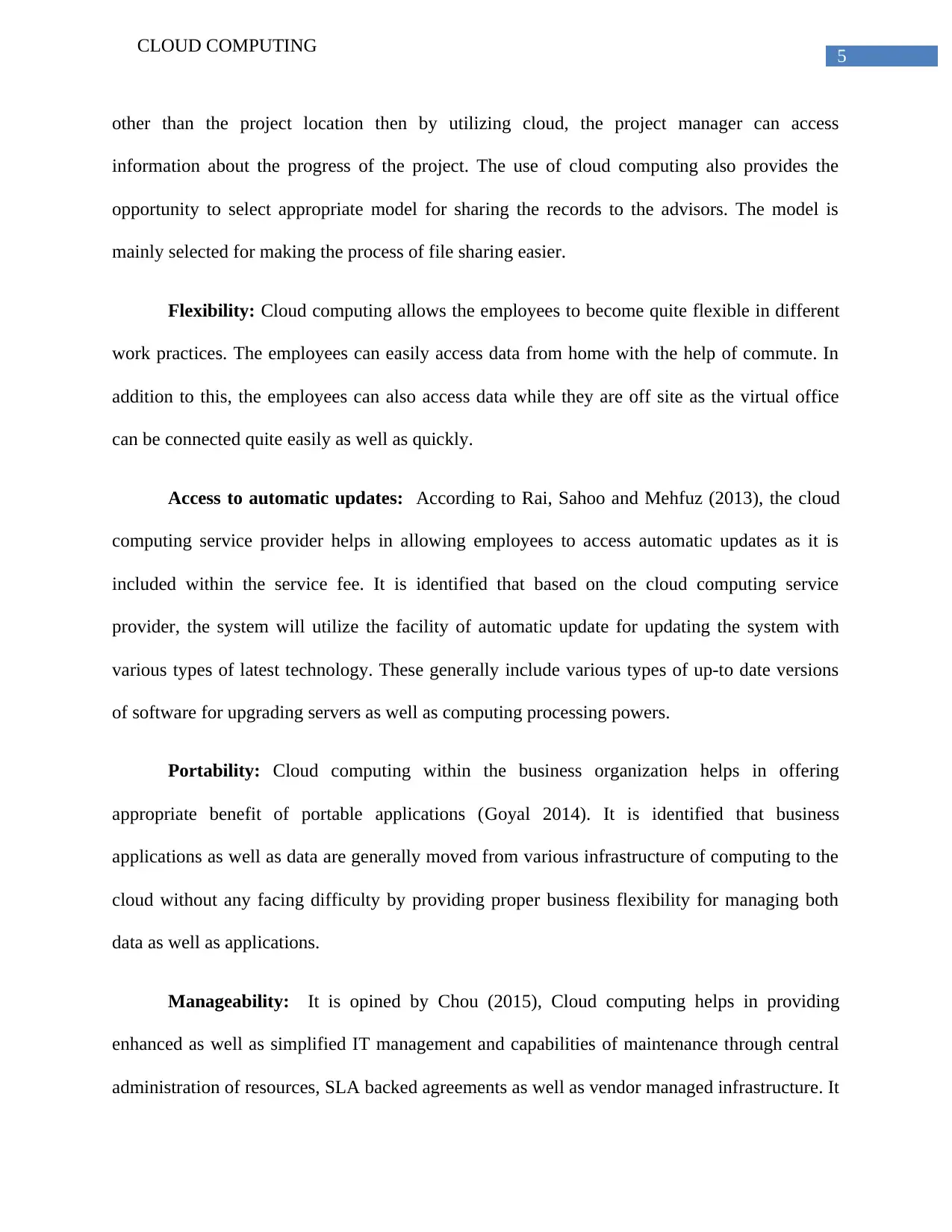
5
CLOUD COMPUTING
other than the project location then by utilizing cloud, the project manager can access
information about the progress of the project. The use of cloud computing also provides the
opportunity to select appropriate model for sharing the records to the advisors. The model is
mainly selected for making the process of file sharing easier.
Flexibility: Cloud computing allows the employees to become quite flexible in different
work practices. The employees can easily access data from home with the help of commute. In
addition to this, the employees can also access data while they are off site as the virtual office
can be connected quite easily as well as quickly.
Access to automatic updates: According to Rai, Sahoo and Mehfuz (2013), the cloud
computing service provider helps in allowing employees to access automatic updates as it is
included within the service fee. It is identified that based on the cloud computing service
provider, the system will utilize the facility of automatic update for updating the system with
various types of latest technology. These generally include various types of up-to date versions
of software for upgrading servers as well as computing processing powers.
Portability: Cloud computing within the business organization helps in offering
appropriate benefit of portable applications (Goyal 2014). It is identified that business
applications as well as data are generally moved from various infrastructure of computing to the
cloud without any facing difficulty by providing proper business flexibility for managing both
data as well as applications.
Manageability: It is opined by Chou (2015), Cloud computing helps in providing
enhanced as well as simplified IT management and capabilities of maintenance through central
administration of resources, SLA backed agreements as well as vendor managed infrastructure. It
CLOUD COMPUTING
other than the project location then by utilizing cloud, the project manager can access
information about the progress of the project. The use of cloud computing also provides the
opportunity to select appropriate model for sharing the records to the advisors. The model is
mainly selected for making the process of file sharing easier.
Flexibility: Cloud computing allows the employees to become quite flexible in different
work practices. The employees can easily access data from home with the help of commute. In
addition to this, the employees can also access data while they are off site as the virtual office
can be connected quite easily as well as quickly.
Access to automatic updates: According to Rai, Sahoo and Mehfuz (2013), the cloud
computing service provider helps in allowing employees to access automatic updates as it is
included within the service fee. It is identified that based on the cloud computing service
provider, the system will utilize the facility of automatic update for updating the system with
various types of latest technology. These generally include various types of up-to date versions
of software for upgrading servers as well as computing processing powers.
Portability: Cloud computing within the business organization helps in offering
appropriate benefit of portable applications (Goyal 2014). It is identified that business
applications as well as data are generally moved from various infrastructure of computing to the
cloud without any facing difficulty by providing proper business flexibility for managing both
data as well as applications.
Manageability: It is opined by Chou (2015), Cloud computing helps in providing
enhanced as well as simplified IT management and capabilities of maintenance through central
administration of resources, SLA backed agreements as well as vendor managed infrastructure. It
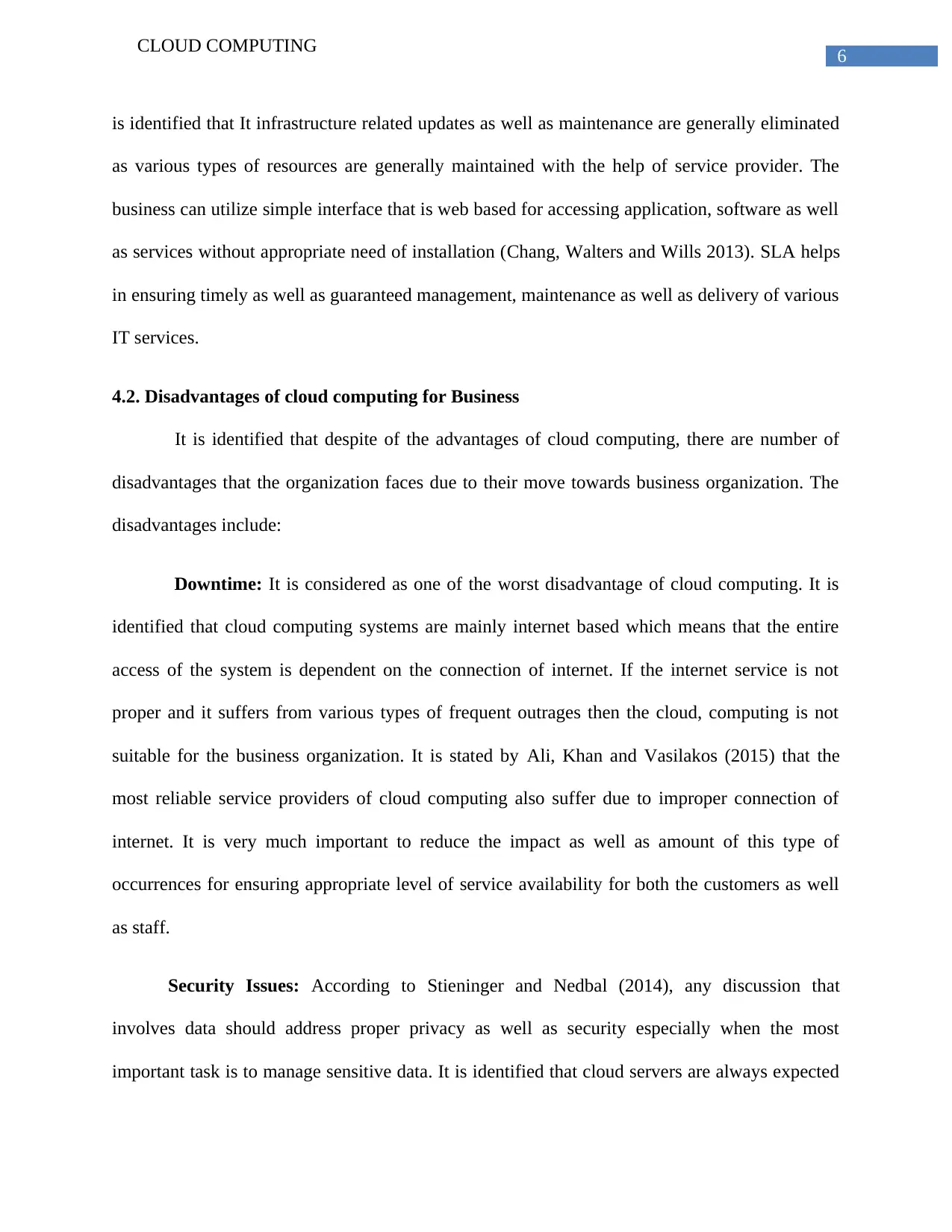
6
CLOUD COMPUTING
is identified that It infrastructure related updates as well as maintenance are generally eliminated
as various types of resources are generally maintained with the help of service provider. The
business can utilize simple interface that is web based for accessing application, software as well
as services without appropriate need of installation (Chang, Walters and Wills 2013). SLA helps
in ensuring timely as well as guaranteed management, maintenance as well as delivery of various
IT services.
4.2. Disadvantages of cloud computing for Business
It is identified that despite of the advantages of cloud computing, there are number of
disadvantages that the organization faces due to their move towards business organization. The
disadvantages include:
Downtime: It is considered as one of the worst disadvantage of cloud computing. It is
identified that cloud computing systems are mainly internet based which means that the entire
access of the system is dependent on the connection of internet. If the internet service is not
proper and it suffers from various types of frequent outrages then the cloud, computing is not
suitable for the business organization. It is stated by Ali, Khan and Vasilakos (2015) that the
most reliable service providers of cloud computing also suffer due to improper connection of
internet. It is very much important to reduce the impact as well as amount of this type of
occurrences for ensuring appropriate level of service availability for both the customers as well
as staff.
Security Issues: According to Stieninger and Nedbal (2014), any discussion that
involves data should address proper privacy as well as security especially when the most
important task is to manage sensitive data. It is identified that cloud servers are always expected
CLOUD COMPUTING
is identified that It infrastructure related updates as well as maintenance are generally eliminated
as various types of resources are generally maintained with the help of service provider. The
business can utilize simple interface that is web based for accessing application, software as well
as services without appropriate need of installation (Chang, Walters and Wills 2013). SLA helps
in ensuring timely as well as guaranteed management, maintenance as well as delivery of various
IT services.
4.2. Disadvantages of cloud computing for Business
It is identified that despite of the advantages of cloud computing, there are number of
disadvantages that the organization faces due to their move towards business organization. The
disadvantages include:
Downtime: It is considered as one of the worst disadvantage of cloud computing. It is
identified that cloud computing systems are mainly internet based which means that the entire
access of the system is dependent on the connection of internet. If the internet service is not
proper and it suffers from various types of frequent outrages then the cloud, computing is not
suitable for the business organization. It is stated by Ali, Khan and Vasilakos (2015) that the
most reliable service providers of cloud computing also suffer due to improper connection of
internet. It is very much important to reduce the impact as well as amount of this type of
occurrences for ensuring appropriate level of service availability for both the customers as well
as staff.
Security Issues: According to Stieninger and Nedbal (2014), any discussion that
involves data should address proper privacy as well as security especially when the most
important task is to manage sensitive data. It is identified that cloud servers are always expected
Paraphrase This Document
Need a fresh take? Get an instant paraphrase of this document with our AI Paraphraser
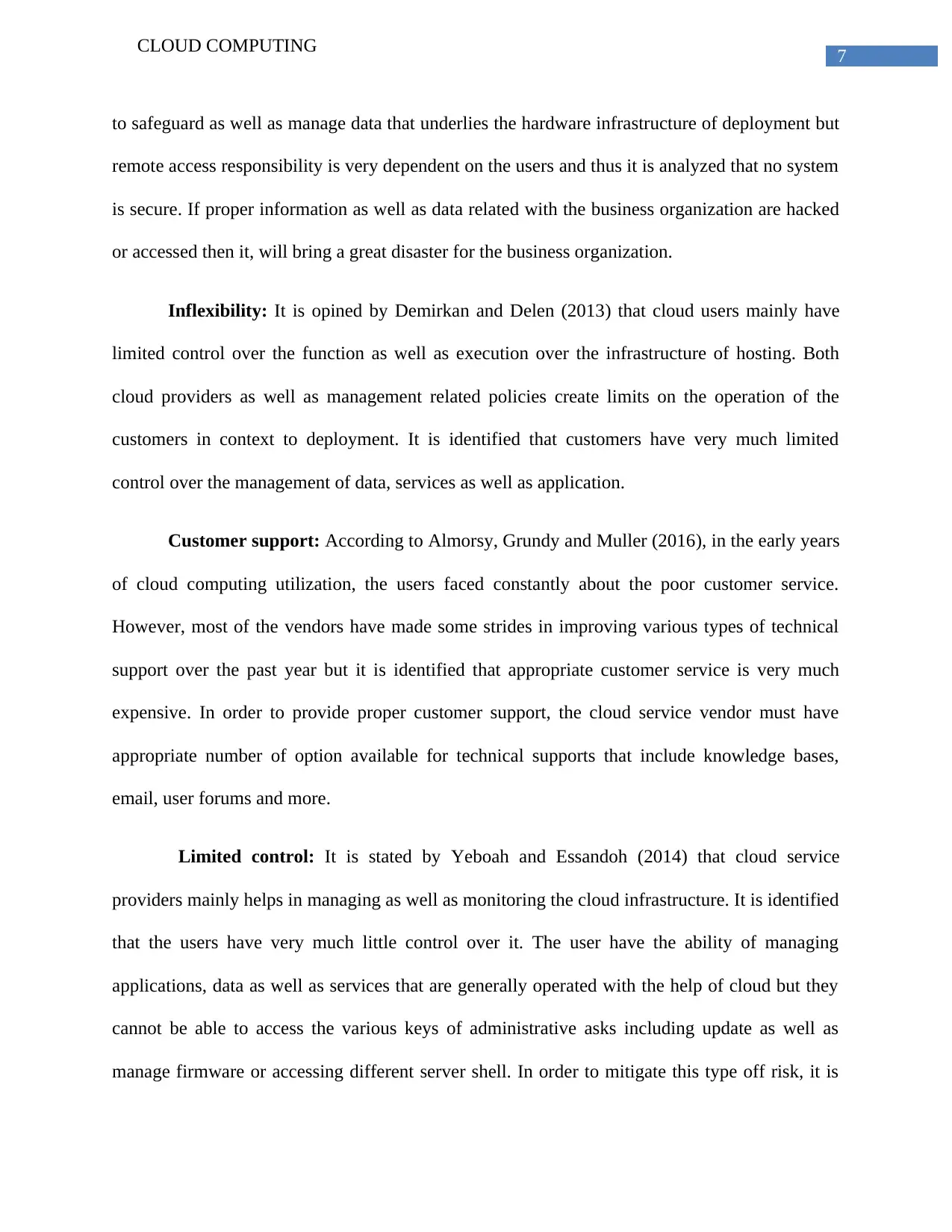
7
CLOUD COMPUTING
to safeguard as well as manage data that underlies the hardware infrastructure of deployment but
remote access responsibility is very dependent on the users and thus it is analyzed that no system
is secure. If proper information as well as data related with the business organization are hacked
or accessed then it, will bring a great disaster for the business organization.
Inflexibility: It is opined by Demirkan and Delen (2013) that cloud users mainly have
limited control over the function as well as execution over the infrastructure of hosting. Both
cloud providers as well as management related policies create limits on the operation of the
customers in context to deployment. It is identified that customers have very much limited
control over the management of data, services as well as application.
Customer support: According to Almorsy, Grundy and Muller (2016), in the early years
of cloud computing utilization, the users faced constantly about the poor customer service.
However, most of the vendors have made some strides in improving various types of technical
support over the past year but it is identified that appropriate customer service is very much
expensive. In order to provide proper customer support, the cloud service vendor must have
appropriate number of option available for technical supports that include knowledge bases,
email, user forums and more.
Limited control: It is stated by Yeboah and Essandoh (2014) that cloud service
providers mainly helps in managing as well as monitoring the cloud infrastructure. It is identified
that the users have very much little control over it. The user have the ability of managing
applications, data as well as services that are generally operated with the help of cloud but they
cannot be able to access the various keys of administrative asks including update as well as
manage firmware or accessing different server shell. In order to mitigate this type off risk, it is
CLOUD COMPUTING
to safeguard as well as manage data that underlies the hardware infrastructure of deployment but
remote access responsibility is very dependent on the users and thus it is analyzed that no system
is secure. If proper information as well as data related with the business organization are hacked
or accessed then it, will bring a great disaster for the business organization.
Inflexibility: It is opined by Demirkan and Delen (2013) that cloud users mainly have
limited control over the function as well as execution over the infrastructure of hosting. Both
cloud providers as well as management related policies create limits on the operation of the
customers in context to deployment. It is identified that customers have very much limited
control over the management of data, services as well as application.
Customer support: According to Almorsy, Grundy and Muller (2016), in the early years
of cloud computing utilization, the users faced constantly about the poor customer service.
However, most of the vendors have made some strides in improving various types of technical
support over the past year but it is identified that appropriate customer service is very much
expensive. In order to provide proper customer support, the cloud service vendor must have
appropriate number of option available for technical supports that include knowledge bases,
email, user forums and more.
Limited control: It is stated by Yeboah and Essandoh (2014) that cloud service
providers mainly helps in managing as well as monitoring the cloud infrastructure. It is identified
that the users have very much little control over it. The user have the ability of managing
applications, data as well as services that are generally operated with the help of cloud but they
cannot be able to access the various keys of administrative asks including update as well as
manage firmware or accessing different server shell. In order to mitigate this type off risk, it is
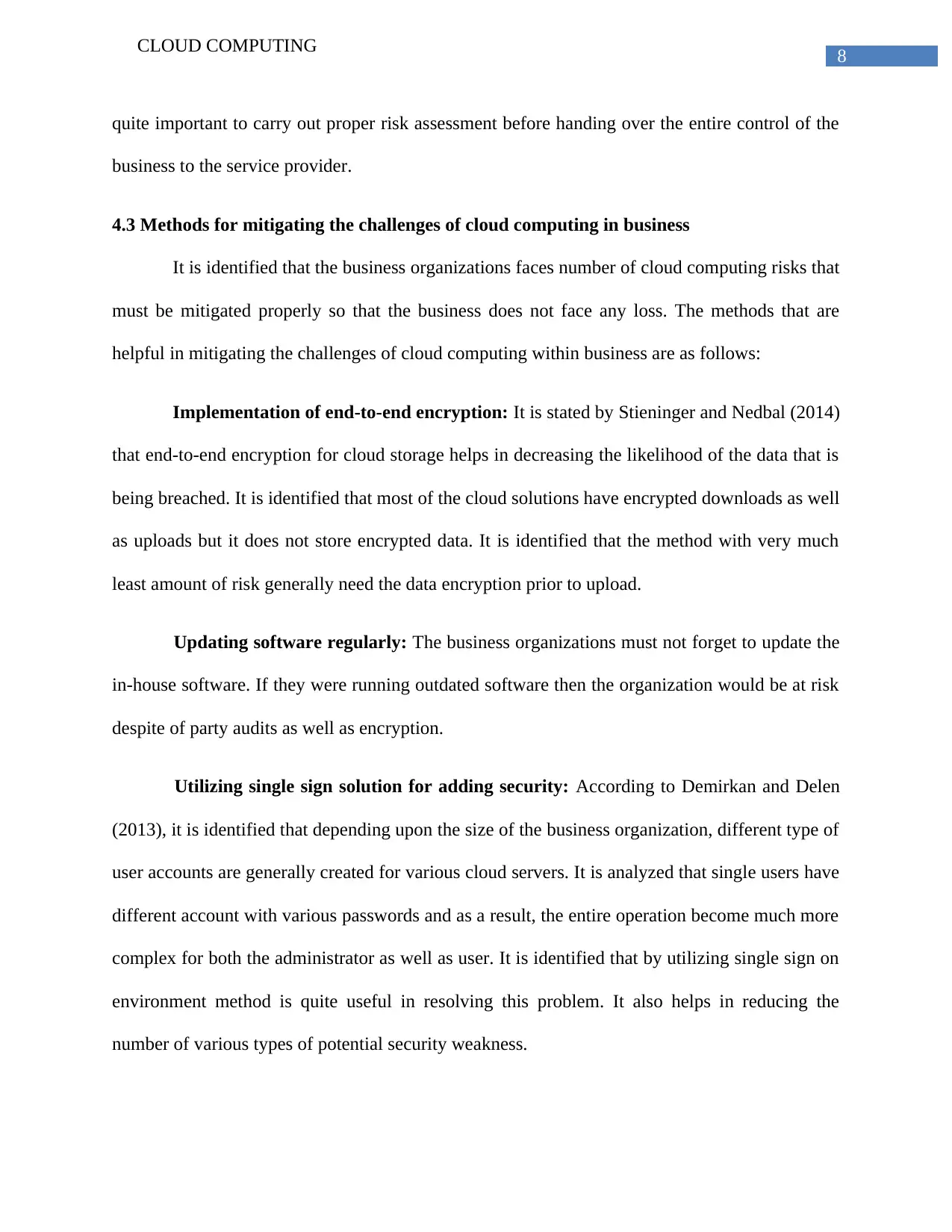
8
CLOUD COMPUTING
quite important to carry out proper risk assessment before handing over the entire control of the
business to the service provider.
4.3 Methods for mitigating the challenges of cloud computing in business
It is identified that the business organizations faces number of cloud computing risks that
must be mitigated properly so that the business does not face any loss. The methods that are
helpful in mitigating the challenges of cloud computing within business are as follows:
Implementation of end-to-end encryption: It is stated by Stieninger and Nedbal (2014)
that end-to-end encryption for cloud storage helps in decreasing the likelihood of the data that is
being breached. It is identified that most of the cloud solutions have encrypted downloads as well
as uploads but it does not store encrypted data. It is identified that the method with very much
least amount of risk generally need the data encryption prior to upload.
Updating software regularly: The business organizations must not forget to update the
in-house software. If they were running outdated software then the organization would be at risk
despite of party audits as well as encryption.
Utilizing single sign solution for adding security: According to Demirkan and Delen
(2013), it is identified that depending upon the size of the business organization, different type of
user accounts are generally created for various cloud servers. It is analyzed that single users have
different account with various passwords and as a result, the entire operation become much more
complex for both the administrator as well as user. It is identified that by utilizing single sign on
environment method is quite useful in resolving this problem. It also helps in reducing the
number of various types of potential security weakness.
CLOUD COMPUTING
quite important to carry out proper risk assessment before handing over the entire control of the
business to the service provider.
4.3 Methods for mitigating the challenges of cloud computing in business
It is identified that the business organizations faces number of cloud computing risks that
must be mitigated properly so that the business does not face any loss. The methods that are
helpful in mitigating the challenges of cloud computing within business are as follows:
Implementation of end-to-end encryption: It is stated by Stieninger and Nedbal (2014)
that end-to-end encryption for cloud storage helps in decreasing the likelihood of the data that is
being breached. It is identified that most of the cloud solutions have encrypted downloads as well
as uploads but it does not store encrypted data. It is identified that the method with very much
least amount of risk generally need the data encryption prior to upload.
Updating software regularly: The business organizations must not forget to update the
in-house software. If they were running outdated software then the organization would be at risk
despite of party audits as well as encryption.
Utilizing single sign solution for adding security: According to Demirkan and Delen
(2013), it is identified that depending upon the size of the business organization, different type of
user accounts are generally created for various cloud servers. It is analyzed that single users have
different account with various passwords and as a result, the entire operation become much more
complex for both the administrator as well as user. It is identified that by utilizing single sign on
environment method is quite useful in resolving this problem. It also helps in reducing the
number of various types of potential security weakness.
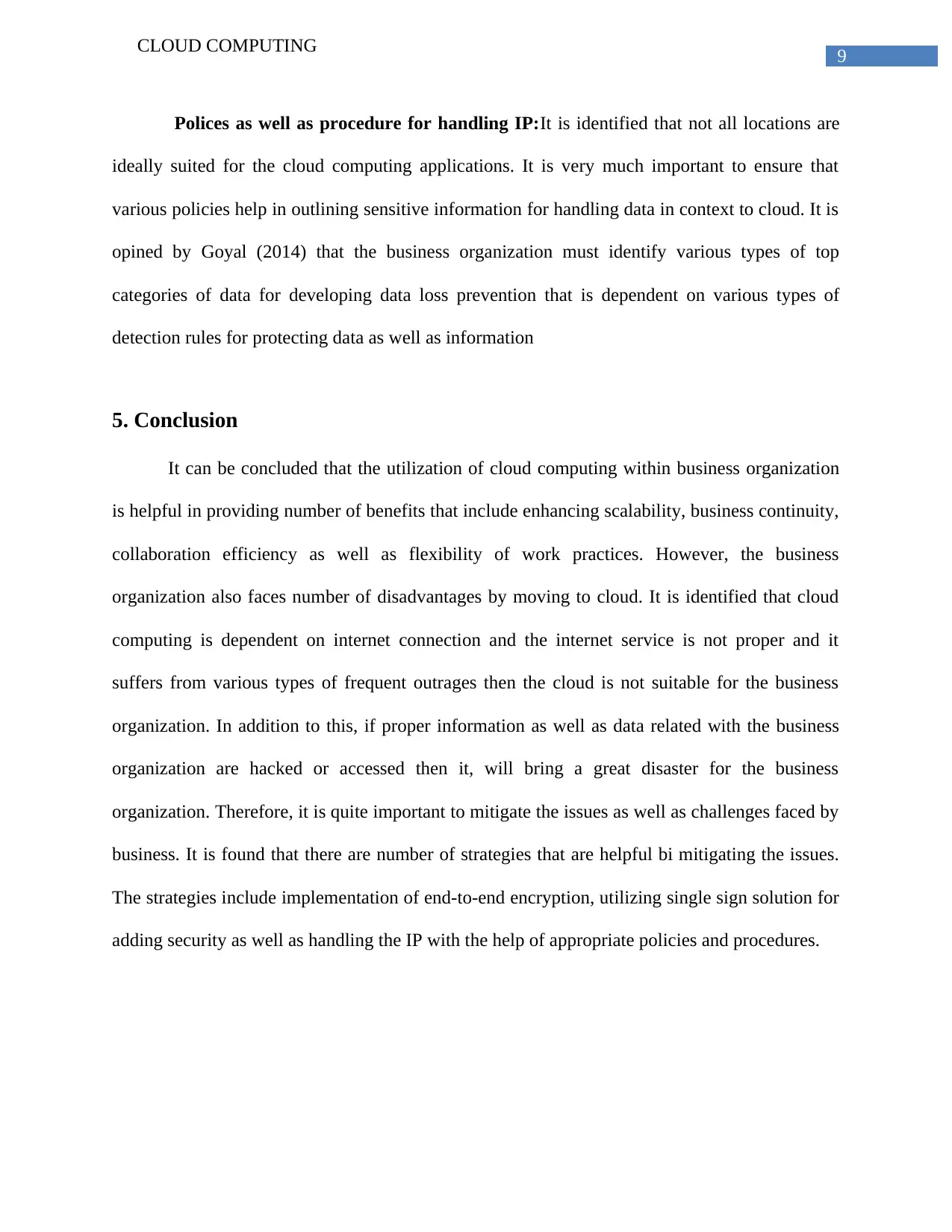
9
CLOUD COMPUTING
Polices as well as procedure for handling IP:It is identified that not all locations are
ideally suited for the cloud computing applications. It is very much important to ensure that
various policies help in outlining sensitive information for handling data in context to cloud. It is
opined by Goyal (2014) that the business organization must identify various types of top
categories of data for developing data loss prevention that is dependent on various types of
detection rules for protecting data as well as information
5. Conclusion
It can be concluded that the utilization of cloud computing within business organization
is helpful in providing number of benefits that include enhancing scalability, business continuity,
collaboration efficiency as well as flexibility of work practices. However, the business
organization also faces number of disadvantages by moving to cloud. It is identified that cloud
computing is dependent on internet connection and the internet service is not proper and it
suffers from various types of frequent outrages then the cloud is not suitable for the business
organization. In addition to this, if proper information as well as data related with the business
organization are hacked or accessed then it, will bring a great disaster for the business
organization. Therefore, it is quite important to mitigate the issues as well as challenges faced by
business. It is found that there are number of strategies that are helpful bi mitigating the issues.
The strategies include implementation of end-to-end encryption, utilizing single sign solution for
adding security as well as handling the IP with the help of appropriate policies and procedures.
CLOUD COMPUTING
Polices as well as procedure for handling IP:It is identified that not all locations are
ideally suited for the cloud computing applications. It is very much important to ensure that
various policies help in outlining sensitive information for handling data in context to cloud. It is
opined by Goyal (2014) that the business organization must identify various types of top
categories of data for developing data loss prevention that is dependent on various types of
detection rules for protecting data as well as information
5. Conclusion
It can be concluded that the utilization of cloud computing within business organization
is helpful in providing number of benefits that include enhancing scalability, business continuity,
collaboration efficiency as well as flexibility of work practices. However, the business
organization also faces number of disadvantages by moving to cloud. It is identified that cloud
computing is dependent on internet connection and the internet service is not proper and it
suffers from various types of frequent outrages then the cloud is not suitable for the business
organization. In addition to this, if proper information as well as data related with the business
organization are hacked or accessed then it, will bring a great disaster for the business
organization. Therefore, it is quite important to mitigate the issues as well as challenges faced by
business. It is found that there are number of strategies that are helpful bi mitigating the issues.
The strategies include implementation of end-to-end encryption, utilizing single sign solution for
adding security as well as handling the IP with the help of appropriate policies and procedures.
Secure Best Marks with AI Grader
Need help grading? Try our AI Grader for instant feedback on your assignments.
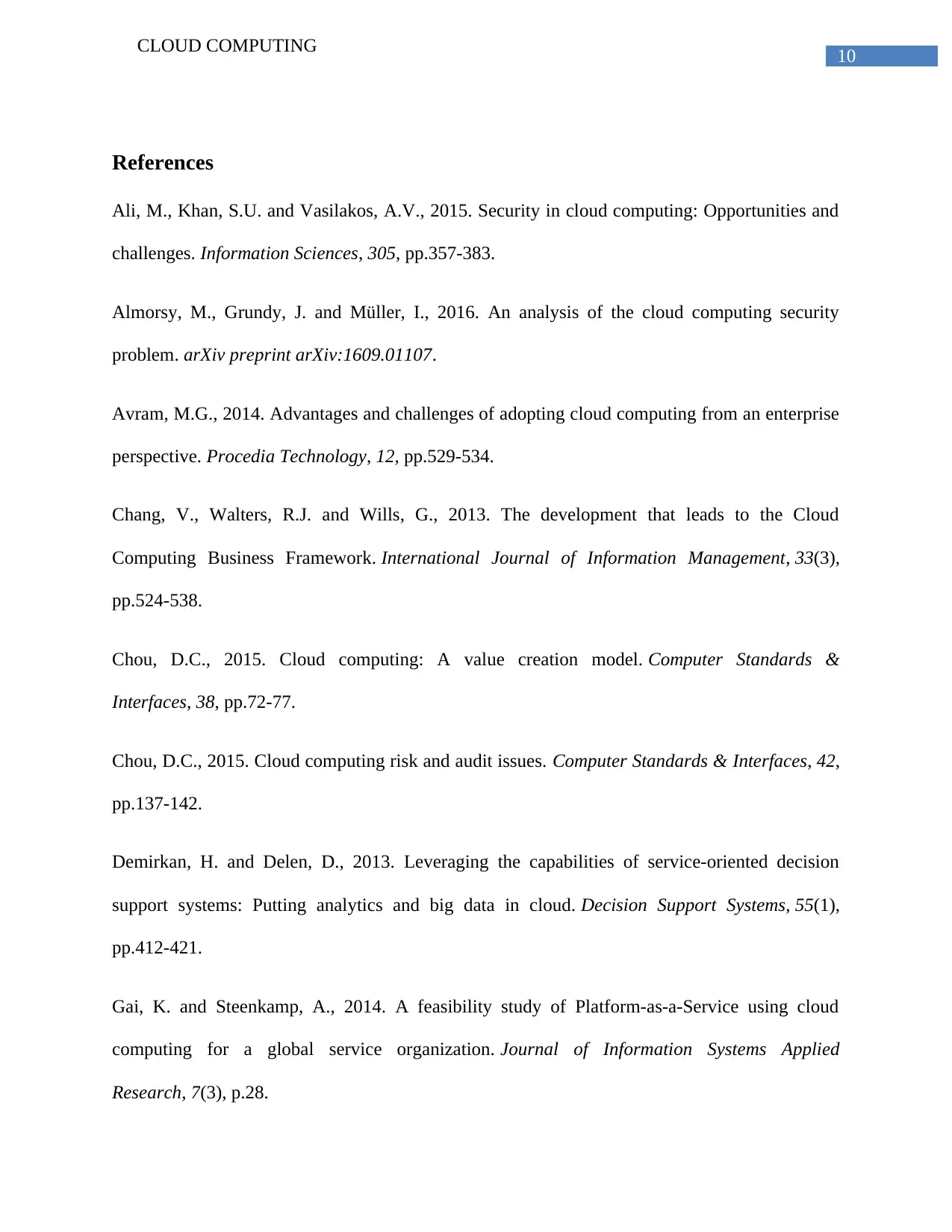
10
CLOUD COMPUTING
References
Ali, M., Khan, S.U. and Vasilakos, A.V., 2015. Security in cloud computing: Opportunities and
challenges. Information Sciences, 305, pp.357-383.
Almorsy, M., Grundy, J. and Müller, I., 2016. An analysis of the cloud computing security
problem. arXiv preprint arXiv:1609.01107.
Avram, M.G., 2014. Advantages and challenges of adopting cloud computing from an enterprise
perspective. Procedia Technology, 12, pp.529-534.
Chang, V., Walters, R.J. and Wills, G., 2013. The development that leads to the Cloud
Computing Business Framework. International Journal of Information Management, 33(3),
pp.524-538.
Chou, D.C., 2015. Cloud computing: A value creation model. Computer Standards &
Interfaces, 38, pp.72-77.
Chou, D.C., 2015. Cloud computing risk and audit issues. Computer Standards & Interfaces, 42,
pp.137-142.
Demirkan, H. and Delen, D., 2013. Leveraging the capabilities of service-oriented decision
support systems: Putting analytics and big data in cloud. Decision Support Systems, 55(1),
pp.412-421.
Gai, K. and Steenkamp, A., 2014. A feasibility study of Platform-as-a-Service using cloud
computing for a global service organization. Journal of Information Systems Applied
Research, 7(3), p.28.
CLOUD COMPUTING
References
Ali, M., Khan, S.U. and Vasilakos, A.V., 2015. Security in cloud computing: Opportunities and
challenges. Information Sciences, 305, pp.357-383.
Almorsy, M., Grundy, J. and Müller, I., 2016. An analysis of the cloud computing security
problem. arXiv preprint arXiv:1609.01107.
Avram, M.G., 2014. Advantages and challenges of adopting cloud computing from an enterprise
perspective. Procedia Technology, 12, pp.529-534.
Chang, V., Walters, R.J. and Wills, G., 2013. The development that leads to the Cloud
Computing Business Framework. International Journal of Information Management, 33(3),
pp.524-538.
Chou, D.C., 2015. Cloud computing: A value creation model. Computer Standards &
Interfaces, 38, pp.72-77.
Chou, D.C., 2015. Cloud computing risk and audit issues. Computer Standards & Interfaces, 42,
pp.137-142.
Demirkan, H. and Delen, D., 2013. Leveraging the capabilities of service-oriented decision
support systems: Putting analytics and big data in cloud. Decision Support Systems, 55(1),
pp.412-421.
Gai, K. and Steenkamp, A., 2014. A feasibility study of Platform-as-a-Service using cloud
computing for a global service organization. Journal of Information Systems Applied
Research, 7(3), p.28.
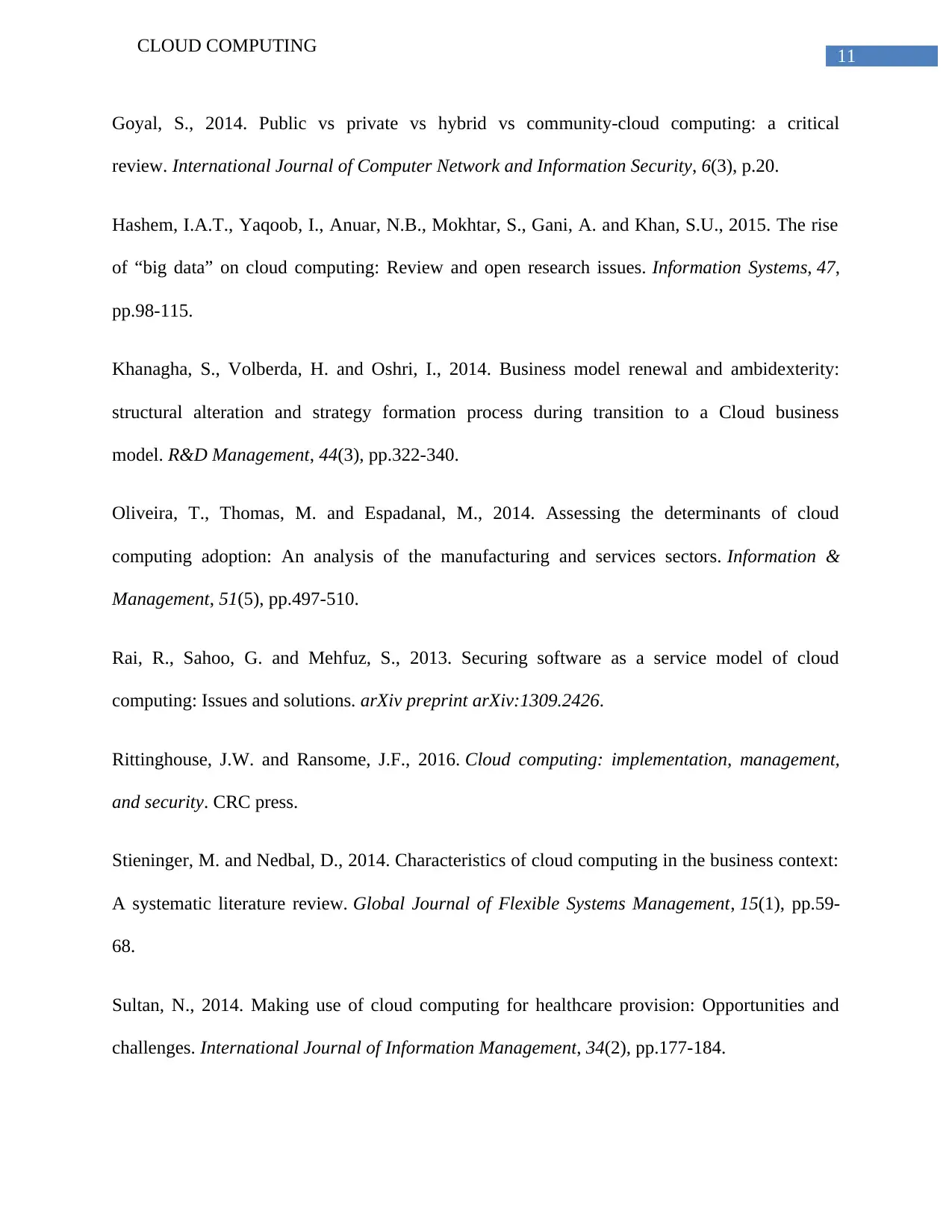
11
CLOUD COMPUTING
Goyal, S., 2014. Public vs private vs hybrid vs community-cloud computing: a critical
review. International Journal of Computer Network and Information Security, 6(3), p.20.
Hashem, I.A.T., Yaqoob, I., Anuar, N.B., Mokhtar, S., Gani, A. and Khan, S.U., 2015. The rise
of “big data” on cloud computing: Review and open research issues. Information Systems, 47,
pp.98-115.
Khanagha, S., Volberda, H. and Oshri, I., 2014. Business model renewal and ambidexterity:
structural alteration and strategy formation process during transition to a Cloud business
model. R&D Management, 44(3), pp.322-340.
Oliveira, T., Thomas, M. and Espadanal, M., 2014. Assessing the determinants of cloud
computing adoption: An analysis of the manufacturing and services sectors. Information &
Management, 51(5), pp.497-510.
Rai, R., Sahoo, G. and Mehfuz, S., 2013. Securing software as a service model of cloud
computing: Issues and solutions. arXiv preprint arXiv:1309.2426.
Rittinghouse, J.W. and Ransome, J.F., 2016. Cloud computing: implementation, management,
and security. CRC press.
Stieninger, M. and Nedbal, D., 2014. Characteristics of cloud computing in the business context:
A systematic literature review. Global Journal of Flexible Systems Management, 15(1), pp.59-
68.
Sultan, N., 2014. Making use of cloud computing for healthcare provision: Opportunities and
challenges. International Journal of Information Management, 34(2), pp.177-184.
CLOUD COMPUTING
Goyal, S., 2014. Public vs private vs hybrid vs community-cloud computing: a critical
review. International Journal of Computer Network and Information Security, 6(3), p.20.
Hashem, I.A.T., Yaqoob, I., Anuar, N.B., Mokhtar, S., Gani, A. and Khan, S.U., 2015. The rise
of “big data” on cloud computing: Review and open research issues. Information Systems, 47,
pp.98-115.
Khanagha, S., Volberda, H. and Oshri, I., 2014. Business model renewal and ambidexterity:
structural alteration and strategy formation process during transition to a Cloud business
model. R&D Management, 44(3), pp.322-340.
Oliveira, T., Thomas, M. and Espadanal, M., 2014. Assessing the determinants of cloud
computing adoption: An analysis of the manufacturing and services sectors. Information &
Management, 51(5), pp.497-510.
Rai, R., Sahoo, G. and Mehfuz, S., 2013. Securing software as a service model of cloud
computing: Issues and solutions. arXiv preprint arXiv:1309.2426.
Rittinghouse, J.W. and Ransome, J.F., 2016. Cloud computing: implementation, management,
and security. CRC press.
Stieninger, M. and Nedbal, D., 2014. Characteristics of cloud computing in the business context:
A systematic literature review. Global Journal of Flexible Systems Management, 15(1), pp.59-
68.
Sultan, N., 2014. Making use of cloud computing for healthcare provision: Opportunities and
challenges. International Journal of Information Management, 34(2), pp.177-184.
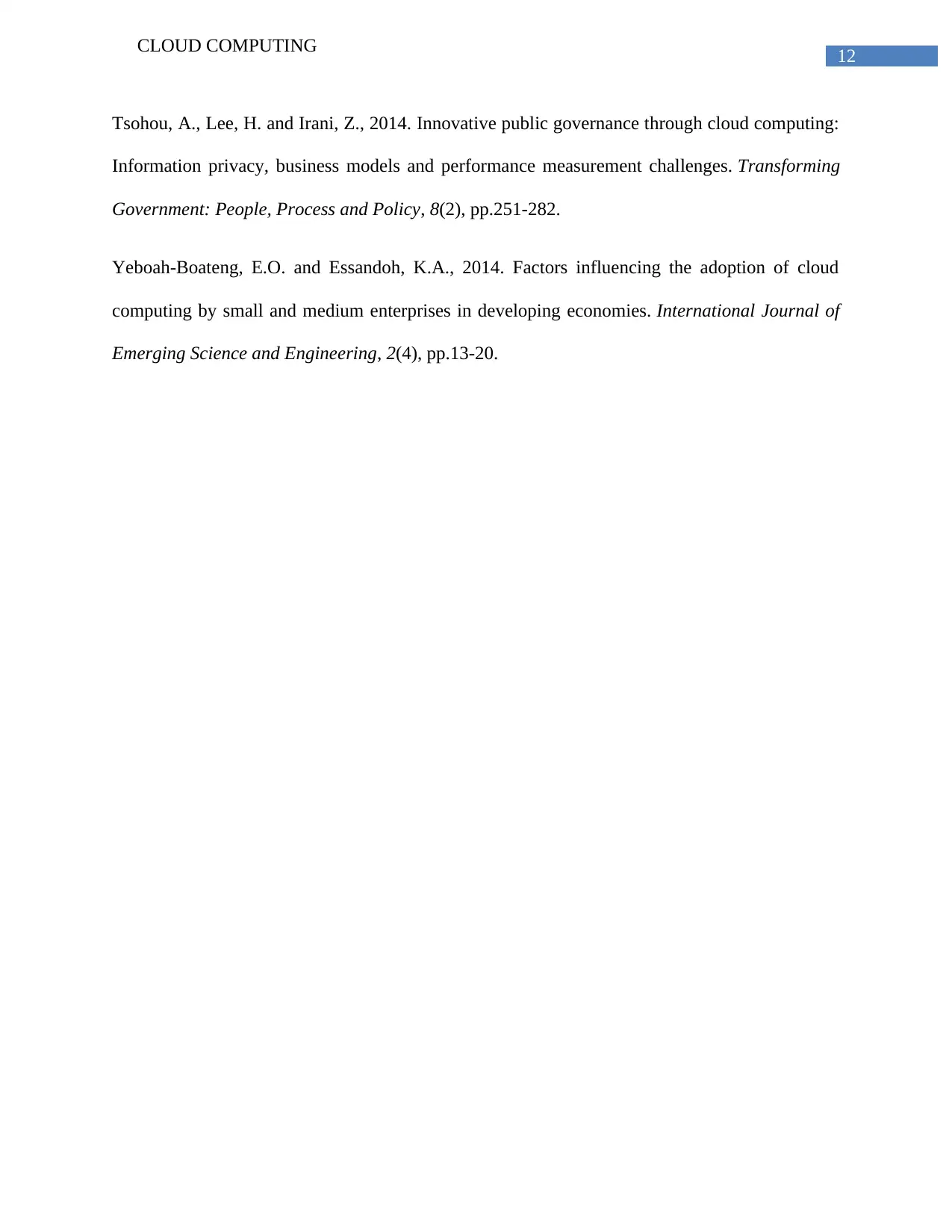
12
CLOUD COMPUTING
Tsohou, A., Lee, H. and Irani, Z., 2014. Innovative public governance through cloud computing:
Information privacy, business models and performance measurement challenges. Transforming
Government: People, Process and Policy, 8(2), pp.251-282.
Yeboah-Boateng, E.O. and Essandoh, K.A., 2014. Factors influencing the adoption of cloud
computing by small and medium enterprises in developing economies. International Journal of
Emerging Science and Engineering, 2(4), pp.13-20.
CLOUD COMPUTING
Tsohou, A., Lee, H. and Irani, Z., 2014. Innovative public governance through cloud computing:
Information privacy, business models and performance measurement challenges. Transforming
Government: People, Process and Policy, 8(2), pp.251-282.
Yeboah-Boateng, E.O. and Essandoh, K.A., 2014. Factors influencing the adoption of cloud
computing by small and medium enterprises in developing economies. International Journal of
Emerging Science and Engineering, 2(4), pp.13-20.
1 out of 13
Related Documents
Your All-in-One AI-Powered Toolkit for Academic Success.
+13062052269
info@desklib.com
Available 24*7 on WhatsApp / Email
![[object Object]](/_next/static/media/star-bottom.7253800d.svg)
Unlock your academic potential
© 2024 | Zucol Services PVT LTD | All rights reserved.




